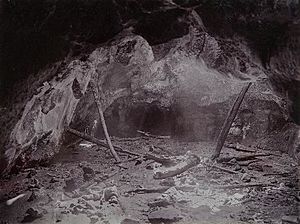H. H. Tilbrook facts for kids
Henry Hammond Tilbrook (1848–1937) was an amazing Australian photographer, inventor, and traveler. He was born in Wales but moved to Australia when he was young. Later in his life, he even helped start a newspaper called the Northern Argus in South Australia.
Contents
Henry Tilbrook's Story
Henry Tilbrook was born in Llandudno, Wales, in 1848. When he was about six years old, his family sailed to South Australia on a ship called the Albermarle.
He worked for a short time setting type for a newspaper in Adelaide. He also worked as a lamb minder. When he was older, Henry heard about the exciting gold rush in New Zealand. He decided to try his luck there, hoping to find gold. After not finding any gold, he worked for another newspaper in New Zealand.
Soon after returning from New Zealand, Henry Tilbrook started his own newspaper, the Northern Argus, in Clare. The very first edition was published on February 19, 1869, when he was 21 years old. On January 1, 1870, he married Marianne Clode in Adelaide. Henry Tilbrook passed away on September 9, 1937, in St Peters.
Photography Adventures
In 1870, Henry Tilbrook started taking photos. He used a special method called the dry plate process. When he retired in 1891, photography became his main focus. Henry truly believed that photos were the best way to record images clearly and accurately. He always cared about how good his pictures looked.
Henry didn't like the blurry photos that some other photographers were taking back then. He thought that to show the true beauty of the Australian landscape, his pictures needed to be sharp and clear. He once said that blurry photos were "a thing to be avoided and shunned, even banned."
Exploring Australia with a Camera
After he retired, Henry went on many photography trips between 1894 and 1905. He traveled all over the Australian outback to capture the landscape. He mostly explored areas around Mount Gambier and the Flinders Ranges. He also visited many smaller towns and regions. Henry didn't sell the photos he took on these trips. However, some of his pictures were used in 1901 to decorate train carriages.
Even though photography was his main goal, Henry also loved hunting. Many of his early trips were for hunting. These trips actually gave him the idea to bring his camera along on future adventures. In his diary, he wrote about his 1894 trip to the Flinders Ranges: "although I took my combined hammerless gun and rifle with me, I decided as my main objective to obtain photographic records of the scenes of our explorations."
When he was on his photography trips, he often spent time alone with his camera. This meant carrying very heavy bags of camera gear. He once wrote about carrying "thirty-eight pounds’ weight of photographic apparatus" to take pictures of Mount Gambier.
Tricky Photography on the Go
Not only was his equipment heavy, but developing the photos was also hard while traveling. In the evenings, he would change his photo plates in a tent. He would put his upper body inside a special dark bag made by his wife. This bag had a ruby glass window that only let in light that wouldn't harm his photo plates. This was like a portable darkroom!
In 1905, when he was 57, Henry went on his last big trip. He visited Mt. Gambier again and also went into Victoria. By this time, he was having some serious health problems. But this never stopped his desire to travel and take photos. He wrote in his diary about walking through a muddy path with nearly twenty kilograms of equipment. He remembered his doctor's warning not to do "violent exercise" or carry "heavy weights."
On this last trip, he explored several cave formations near Mumbannar, Victoria. Inside these dark limestone caves, he used an early form of flash photography. He would burn a special material called magnesium ribbon during long photo exposures, sometimes up to forty minutes! This created detailed pictures of the dark cave interiors.
Clever Photography Tricks
Henry Tilbrook was very creative in how he took his photos. He was one of the first to use artificial light. He also had a clever way to include himself in his pictures. He would use a long piece of thread. One end was tied to the camera's shutter button. The other end ran through a series of metal pegs to where he was standing in the photo. When he pulled the thread tight, it would take the picture! To make sure the camera didn't shake, he used a bullet shell that would fall to the ground after the picture was taken.
Because of this method, Henry was able to be in many of his famous photographs. He also included himself in many group photos from his trips. He became well-known for his self-portrait works, which were even used on passenger trains around Adelaide. He once heard a story about a lady who said, "I came up in a carriage with Mr Henry Tilbrook." When asked where he was going, she replied that she "left him in the train. He was sitting on a rock – in a picture."
Henry Tilbrook's Legacy
Henry Tilbrook left behind many amazing photographs. These pictures give us a detailed look into what life was like in South Australia in the late 1800s. But his biggest contribution was starting his newspaper, the Northern Argus.
The newspaper stayed in the Tilbrook family until 1996. Even today, it still provides daily news for the people of Clare and the areas around it. The newspaper's old records are kept safe by the Clare History Group.





